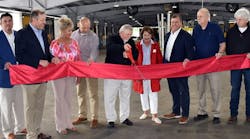FT LAUDERDALE. On the surface, it would seem impossible-- arranging for a load to be picked up by a tractor-trailer that isn’t there. Yet fleets are finding that the right technology package can eliminate a lot of the guessing and manual labor required to construct intricate load plans, saving them time and money while redirecting limited resources to other projects.
Chris Clay, director of customer service for Celadon Group, told FleetOwner here at Manhattan Associates’ “Momentum 2010” user group meeting, that virtual integrated planning – ironically referred to as “VIP” for short – is helping the Indianapolis-based TL carrier increase the load ratio for its fleet of 2,500 trucks and 9,200 dry van trailers while reducing the workload on its operational staff.
“We implemented this system in January this year and have already seen a half-percent increase in our load ratio,” Clay said. “Right now, 58% of the time we’re using the [VIP] system as the primary source for driver and load selection. I’d like to see that get up over 60% but that won’t be easy.”
It won’t be easy, he explained, because load planners just aren’t used to thinking in the terms offered by systems that can project truck capacity farther into the future. For example, Clay said a load scheduled to be picked up in 12 hours might be served by a truck, at that moment, literally two states away.
“That’s tough to get your mind around,” he said. “We’re not used to thinking three or four dispatches out in the future. But this is the kind of capability technology can give you.”
Clay cautioned, however, that such capability is only possible based on the quality of the information loaded into it. “As your business changes, you need to make sure everything you are loading into the system is loaded to correctly match those changes,” he stressed.
But if done right, such “virtual” load planning can save a lot of time and heartburn. “For example, one problem we always had dealt with ‘emergency’ manual changes to the load plan,” Clay said. “We’d make a change and that would have an unexpected ‘ripple effect’ on the freight coming into our system. With it all ‘visible’ within the system, there’s less of a chance of such effects occurring.”
In the future, Clay hopes to use VIP to import more driver- and customer-friendly factors automatically into Celadon’s freight strategy, while freeing up valuable time to deal with operational issues typically shunted to the back burner due to load planning needs.
“Now we can automatically plug in more efficient route benefits for drivers, such as giving them a long mileage run after several short haul loads, and also have loads displayed by urgency so we can get the most critical freight dealt with the first with drivers carrying enough hours,” he explained. “Also, with the load planning burden shifting, operations personnel are already tending to other critical issues that we’ve been placing on the back burner – such as organizing our trailer pools. That’ll also help boost our efficiency as well.”


